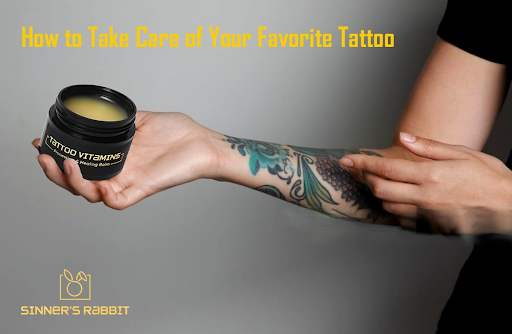Getting a tattoo is an exciting experience, but proper aftercare is essential to ensure your new tattoo heals beautifully for a long time. A fresh tattoo is essentially an open wound, and how you care for it in the first few weeks can significantly impact its appearance and longevity. Neglecting aftercare can lead to infections, fading, or scarring, which can diminish the quality of your tattoo.
The healing process requires attention, patience, and the right aftercare routine. Every step matters, from keeping your tattoo clean and moisturized to avoiding sun exposure and excessive moisture. High-quality tattoo aftercare products, such as Sinners Rabbit Clove Soap, Healing Booster, and Sinner's Rabbit Vitamins Balm, can help speed up healing and maintain vibrant ink.
Understanding tattoo aftercare best practices is crucial, whether you're a first-time tattoo recipient or a seasoned collector. In this guide, we’ll walk you through the essential steps to protect your tattoo, prevent complications, and keep your body art looking fresh and vibrant for years to come. Follow these expert-recommended tips, and your tattoo will heal perfectly, preserving the fine details and bold colors you love. Let’s dive into the ultimate tattoo aftercare routine!
After The First Tattoo Wash
After at least 4 to 5 hours, the bandage can be removed and the tattoo washed safely.
Following complete hand washing, a person can gently wash the tattoo with hypoallergenic soap and warm water with their fingertips.
The moisturizer on the skin will rub off, making the tattoo appear to be pouring ink or a thick, sticky substance. This reaction is typically not a reason for concern because it is simply excess fluid and ink from the tattooing process.
After washing, blot the skin with a clean paper towel and let it air dry for up to an hour. When the region is totally dry, they can apply a tiny coating of moisturizer to the tattoo while leaving it exposed to let the skin breathe.
Suggest: Ultra Soft Skin Cleaner Disposable Towels

Week One: Proper Moisturizing and Healing Tips
Tattoo artists have varying recommendations on when to start moisturizing a new tattoo. Some suggest waiting 24-48 hours, while others advise applying moisturizer immediately after the first wash. It’s always best to follow your artist’s instructions for optimal healing.
During the first few days, the tattooed area may feel warm and appear red, with colors looking more vibrant than usual. As healing progresses, the tattoo will settle, and the brightness will gradually fade to its final appearance. It’s crucial to avoid submerging the tattoo in water or exposing it to excessive moisture for at least 3–6 weeks, except during gentle washes.
Washing frequency depends on lifestyle and environment. Someone in a clean, air-conditioned space may only need to wash their tattoo once daily, whereas individuals in hot, sweaty, or dusty conditions may need to clean it more frequently. Always use clean hands rather than a cloth or towel, as friction can cause irritation and prematurely remove scabs.
Scabbing is a natural part of healing and not necessarily a sign of poor aftercare. Avoid picking or scratching to prevent scarring.
Keeping the tattoo moisturized with a fragrance-free lotion or antibiotic ointment under a bandage (if no allergies exist) can aid faster healing and reduce the risk of scarring. Any redness or mild swelling should subside by the end of the first week.
In general, scabbing is not a sign of improper wound care. Scabs will form anytime the skin is injured and can be a sign of healthy tissue forming underneath the wound.
Second Week
By the start of the second week, scabs will begin to flake off as the healing process continues. During this stage, it’s crucial to handle the tattoo with extra care while washing and moisturizing to avoid accidentally pulling off scabs, which could damage the design.
Itchiness is common during this phase, but scratching must be avoided to prevent irritation and potential scarring. Applying a fragrance-free moisturizer more frequently can help soothe the itch, and using a chilled moisturizer from the refrigerator may provide additional relief.
If the itching becomes too uncomfortable, an over-the-counter antihistamine like Tat-Wax healing balm may help reduce irritation. However, always follow dosage instructions and consult a healthcare provider if needed.
Week three and beyond
The final stage of healing requires patience, as the process slows down. By this point, most larger scabs will have flaked off, though small scabs and patches of dead skin may still be present. These will naturally clear up as healing continues.
During this phase, the tattooed area may appear dry or dull. Regularly applying a fragrance-free moisturizer can help restore hydration, while protecting the tattoo from sun exposure will prevent fading and irritation.
By the end of the third week, the outer layers of the skin should be fully healed, significantly reducing the risk of infection. However, the deeper layers of skin will continue to regenerate, though they require less care.
To keep the tattoo looking vibrant long-term, moisturizing regularly in the following months is essential. Additionally, shielding the tattoo from direct sunlight with clothing while it heals and applying sunscreen once it has fully healed will help preserve its color and detail.
Tips on tattoo Aftercare
Tattoos are a lifelong commitment and require some special care to keep them looking good for many years to come.
What to do
Here’s what a person can take good care of their tattoo:
● Always opt for fragrance-free, hypoallergenic soap and moisturizer when caring for a new tattoo, as harsh chemicals and fragrances can cause irritation or even damage sensitive, healing skin.
● Choose a light, breathable moisturizer to prevent clogged pores, which can lead to breakouts or infection. Before applying moisturizer, ensure the tattooed area is completely dry to avoid trapping excess moisture, which could cause irritation or heat rash.
● Gently wash the tattoo regularly, especially after sweating or exposure to dirt, to keep it clean without over-scrubbing. Staying hydrated by drinking plenty of water also helps maintain skin moisture and elasticity, promoting better healing.
● During the healing process, protect your tattoo from direct sunlight by covering it with clothing or a bandage when necessary. Once healed, using sunscreen will help preserve its color and detail for years to come.
What not to do
Here’s what someone should avoid when it comes to tattoo aftercare:
● Avoid using soaps or moisturizers with fragrances or harsh chemicals, as they can irritate the sensitive, healing tattoo—even if they don’t normally affect your skin.
● Do not pick at scabs, as this can lead to scarring and damage the tattoo’s appearance. Similarly, avoid scratching, even if the tattoo feels itchy, to prevent irritation or infection.
● Stay away from non-cosmetic grade petroleum-based moisturizers, as they can clog pores and hinder the healing process.
● Never apply sunscreen to a fresh tattoo—wait until it has fully healed before using any sun protection. Additionally, avoid swimming in pools, oceans, or hot tubs until the tattoo is completely healed to prevent exposure to bacteria and chemicals that could lead to infection.

